
Delegated asset management can lead to what economists call the “principal–agent problem”: the principal relies on the agent to make decisions on their behalf when the agent’s best interests may run counter to those of the principal.
Agents often have an incentive to choose portfolio allocations designed to minimize their risk of being fired at an all-too-common three-year evaluation horizon, over which both robust strategies and “the best” managers can experience prolonged bouts of underperformance.
A remedy for the principal–agent problem is to better align incentives by adopting longer evaluation periods, combining multiple robust strategies, using non-robust strategies consciously, and practicing transparent management by individual style performance.

It may not be my money, but it is my job.
—Charles Ellis in Investment Policy: How to Win the Loser's Game
Such is how Charley Ellis describes the delicate balancing act facing agents—CIOs, pension sponsors, and consultants—tasked with managing large pools of long-term fiduciary assets. Charley should know. He started the investment management consultancy Greenwich Associates in 1972, chaired the Yale Endowment Investment Committee for nine years, and served on the boards of Vanguard and CFA Institute. In describing the paradox of long-term pools of capital being managed with a very short-term focus, he elaborated on the struggle faced by investment decision makers due to this misalignment:
We should recognize those who are ‘at the controls’ are usually only representatives of an organization and subject to after-the-fact criticism by powerful Monday-morning quarterbacks. These representatives have clear economic incentives to protect their careers.…[T]hey will seek the most acceptable near-term balance between desires for superior returns and avoidance of unusual or unorthodox positions. And above all, they will avoid any unnecessary risk to their own careers (Ellis, 1985, p. 27).
These incentives create what economists call the “principal–agent problem”: the principal is relying on the agent to make decisions on their behalf when the agent often has an incentive to act in alignment with his or her own best interests, which may run counter to the best interests of the principal.
Such a misalignment appears to be evident in the substantial amount of assets allocated to an investment style—the growth style of equity investing—found by a large body of the financial literature not to produce robust returns. Why is this nonperforming style so popular? With a stylized example, we show how agency problems could lead an agent to rationally invest in non-robust strategies—those that do not deliver robust long-term excess returns—hence, not in the best interests of their principals.
Investment Options: Factors and Felines
We highlight the principal–agent problem in delegated asset management with a highly stylized example and demonstrate how agency problems might lead a plan sponsor or CIO (henceforth, “the agent”) to rationally invest in strategies1—including non-robust strategies—that are not in the best interest of principals.
Suppose an agent has the mandate to equally weight investments across eight individual equity funds and is restricted to long-only positions. What should the agent invest in?
We define a set of investments to include eight long-only value strategies, four momentum strategies, four quality strategies, and eight growth strategies. The variations of each strategy are formed on different signals to mimic variations across managers within the given investment style. We select four of the myriad quality definitions, all having an average return close to zero; these signals of quality have recently become popular even though they have not been convincingly demonstrated to be robust sources of long-run return. The growth strategies are the opposite of value and are supposed to underperform the benchmark over the long run.
Over the period 1967–2016, the value-add of the value strategies compared to a capitalization-weighted benchmark ranges from 2.25% (earnings to price) to 0.85% (dividends to price); momentum strategies from 1.77% (2-12 month) to 0.08% (2-6 month); quality strategies from 0.20% (book leverage) to −0.35% (gross margins); and growth strategies from −0.85% (assets to price) to −1.62% (earnings to price).
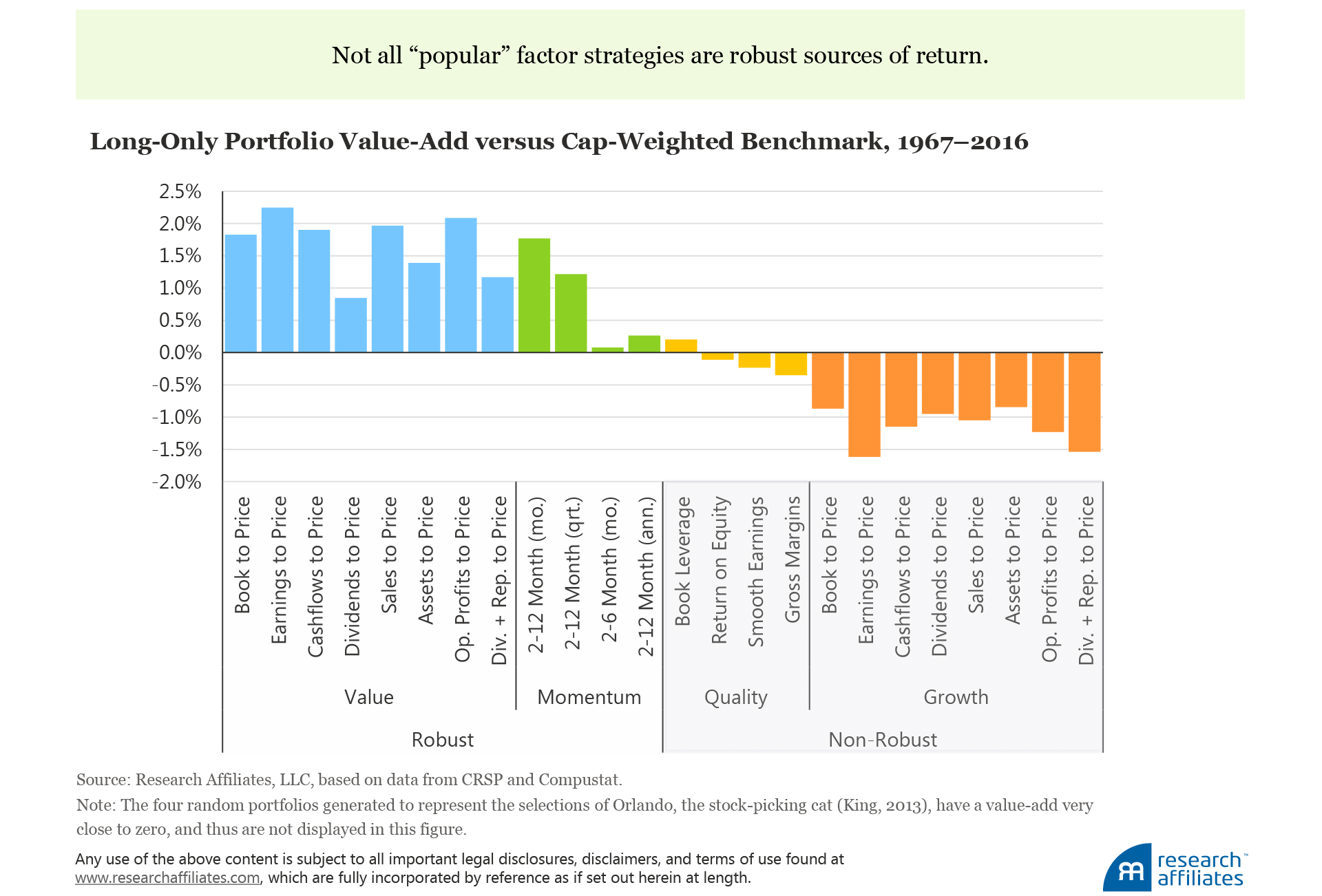
We also add to the roster of investment strategies an intentionally absurd option. In 2012 a ginger Tabby cat from England named Orlando outperformed a panel of stock-picking experts by throwing a toy mouse on a grid representing the companies in the FTSE All-Share Index (King, 2013). We simulate Orlando’s performance by generating four random portfolios with zero expected return and with tracking error identical to the four quality strategies. By design, Orlando’s value-add is very close to zero.
The Investment Options
A naïve investing approach would equally allocate across the eight strategies in our set of investment options that have the largest average value-add (assuming past is prologue). Most sophisticated agents realize, however, the important benefits (for themselves and for investors) of diversifying across funds with low or even negative correlations. The average correlations of the value-add between the style portfolios formed by equally weighting across each style’s strategy variations are:
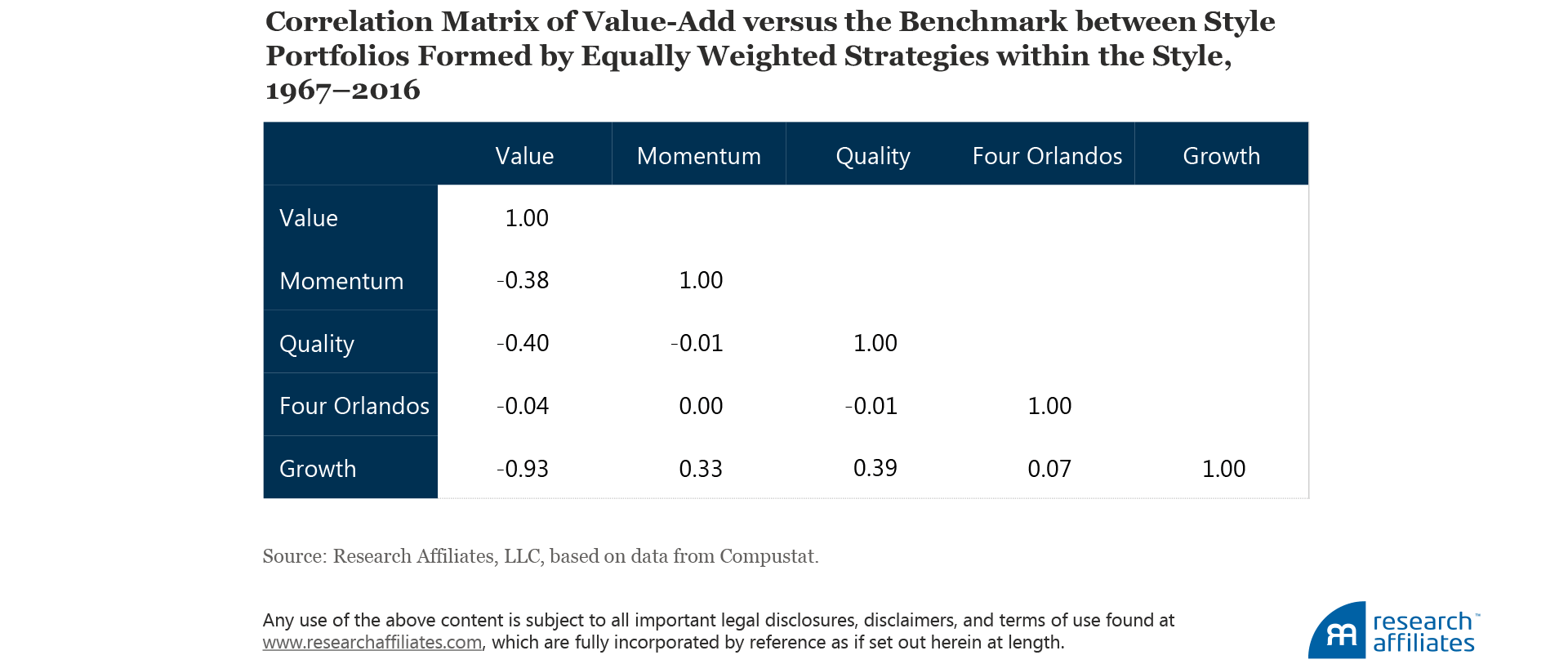
Value has a well-known negative correlation to both momentum and quality, in this case −0.38 and −0.40, respectively. Growth—the opposite of value by construction—is almost perfectly negatively correlated with value, while quality and momentum have little correlation with each other, and unsurprisingly, the four Orlandos are basically uncorrelated with the other four strategies.
To illustrate the investment allocation an agent might choose, given these correlations, we create five different allocations constructed by equally weighting across the strategies within a style as indicated by X and summarized in the following table:
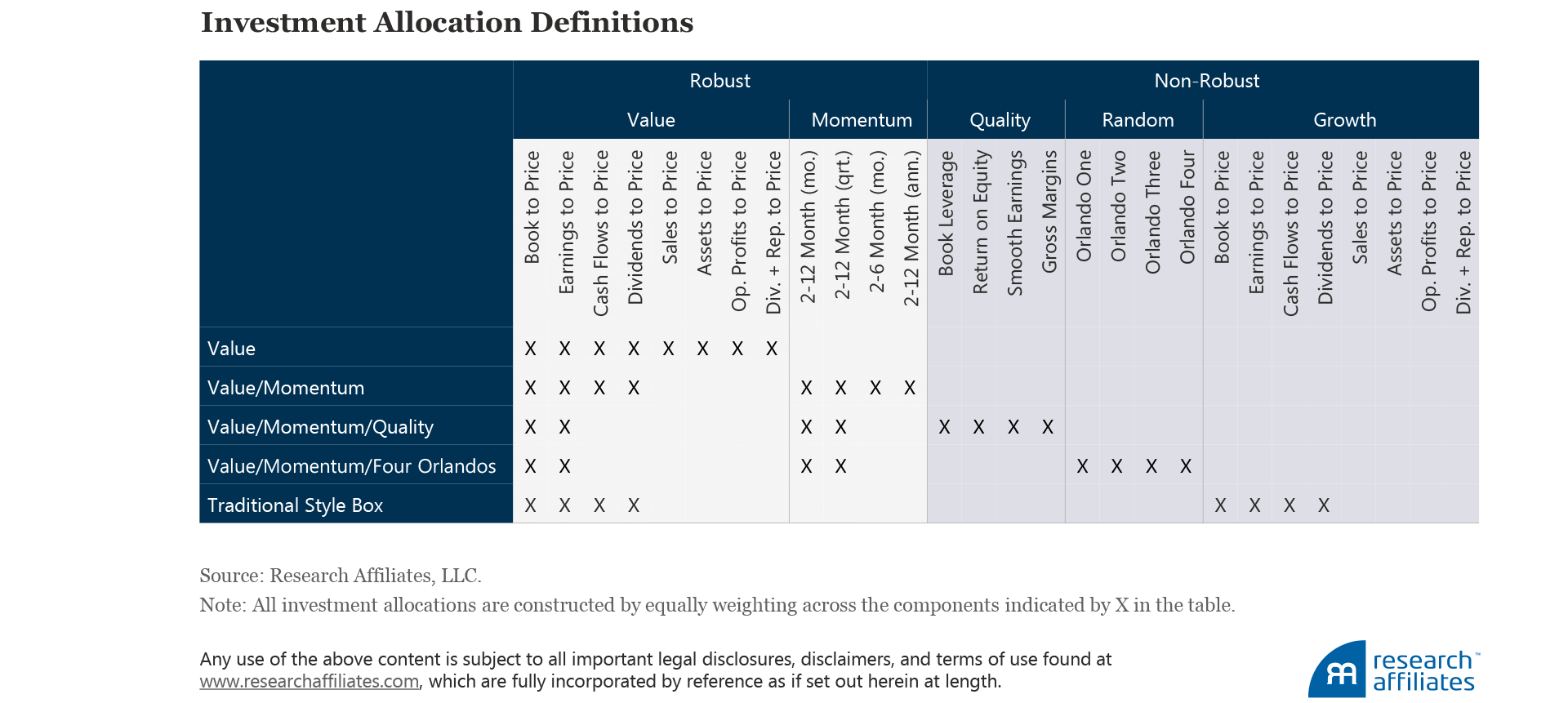
The five allocations form three groups. The first group, composed of Value and Value/Momentum, invests in known robust factors. The second group, composed of Value/Momentum/Quality and Value/Momentum/Four Orlandos, invests in a mix of robust and non-robust factors. The third group, the Traditional Style Box, allocates equally between the robust value strategies and their opposite, non-robust growth strategies.
You’re Fired!
Both robust strategies and “the best” managers can experience prolonged bouts of underperformance, well beyond the standard “long-term” performance measurement horizons of three-to-five years.2 The agent therefore has an incentive to choose an investment allocation designed to minimize their risk of being fired over these three- to five-year stretches.
We select two highly stylized rules for a hypothetical investment board to use in evaluating the agent’s performance:
1) Fire the agent if more than 50% of funds selected by the agent underperform the benchmark in a given period.
2) Fire the agent if the equally weighted portfolio aggregated from the selected funds underperforms the benchmark by more than 1%.
We evaluate the agent under four horizons: 1 year, 3 years, 5 years, and 10 years. We calculate the probability of the agent being fired after investing in each of the five portfolio allocations and under both firing rules. We use “probability” loosely because we are measuring the observed frequency of benchmark underperformance (on a cumulative rolling-return basis) in just one realization (the one we observe) of historical return. These probabilities are meant to be instructive of the agent’s employment risk by highlighting the trade-offs faced in making hypothetical investment allocations; they do not take into account implementation issues such as transaction costs. The probabilities of an agent being fired for holding each of the five investment allocations over the four evaluation horizons are:
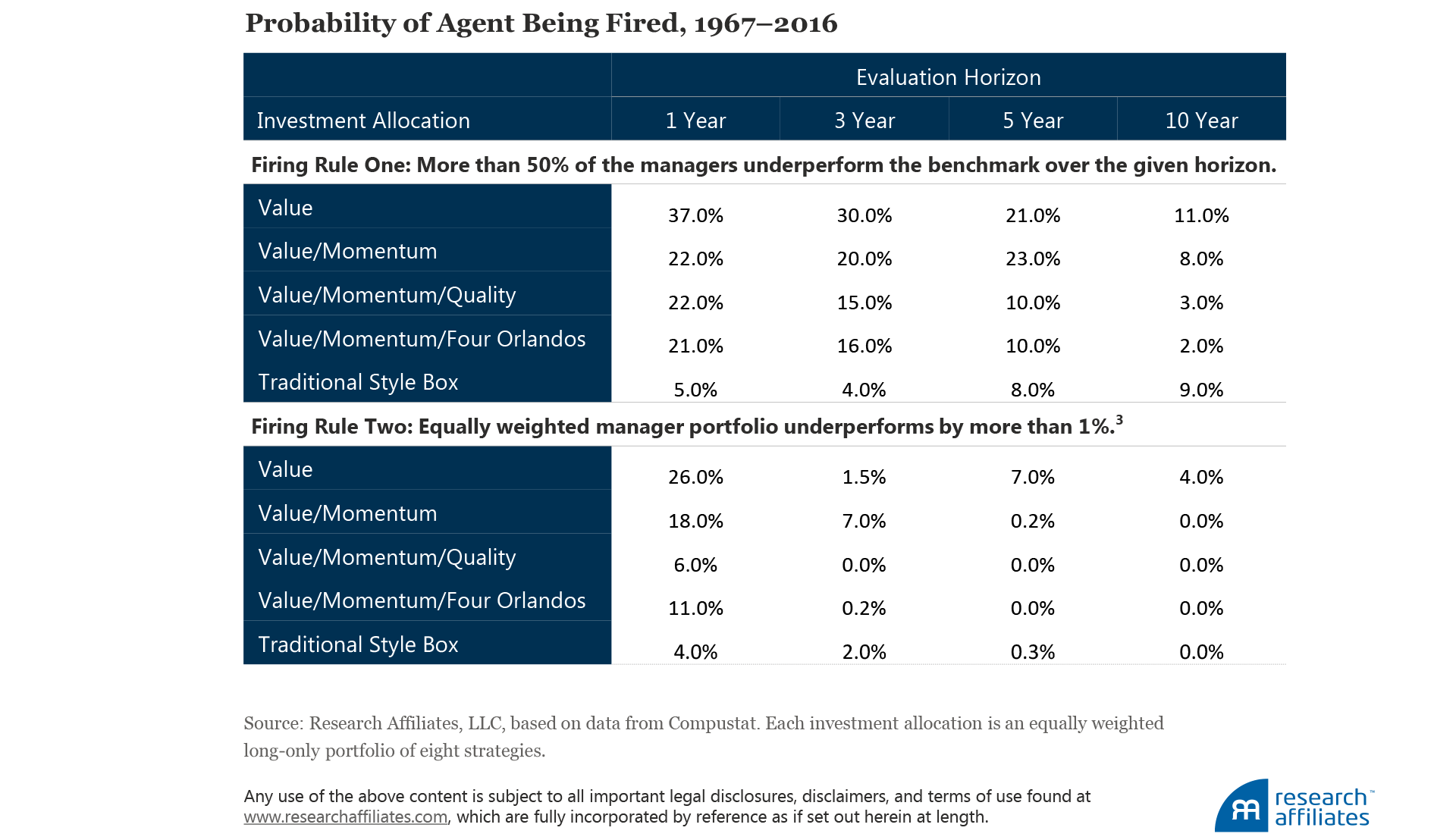
For all horizons and under both firing rules, the agent who allocates only to value funds will have the highest chance of being fired because all the value strategies are highly positively correlated; thus, when one underperforms, they all tend to. When momentum is added to a value portfolio, the chances of being fired decrease in all but one of the horizons because value and momentum are negatively correlated, so that one style’s outperformance tends to offset the other style’s underperformance. When the agent broadens the allocation to include non-robust factors, either the four Orlandos or quality, the chances of being fired further decline almost universally for the same reason.
The Traditional Style Box allocation (50% to value and 50% to growth) dramatically reduces an agent’s chance of being fired because the two almost perfectly negatively correlated investment styles effectively allow agents to “take both sides of the bet.” Equally weighting the two will, however, over a full market cycle, yield close to a zero expected return.
One last observation is that for almost every allocation, lengthening the evaluation horizon results in a lower chance of the agent being fired.
Our example clearly demonstrates an agent can reduce the chances of being fired by allocating across robust negatively correlated strategies such as value and momentum. The same argument holds regardless of the robustness of the strategy. That is, adding uncorrelated or negatively correlated funds, even those with zero or negative expected return, will significantly reduce the agent’s risk of being fired.
Agency Cost
We can bring into focus the potential conflict between agent and principal (i.e., the degree to which the agent’s bias toward low- to negatively correlated strategies can potentially hurt the principal) by comparing the long-term performance of the five investment allocations with the agent’s chances of being fired at a three-year evaluation horizon when invested in each of the five allocations; we use three years because it is a very common evaluation time frame chosen by principals. We see that the best-performing allocations over the long term are the same allocations which, over the short term, have the highest chances of getting the agent fired.
The key performance characteristics of the five investment allocations for the 1967–2016 period are:4
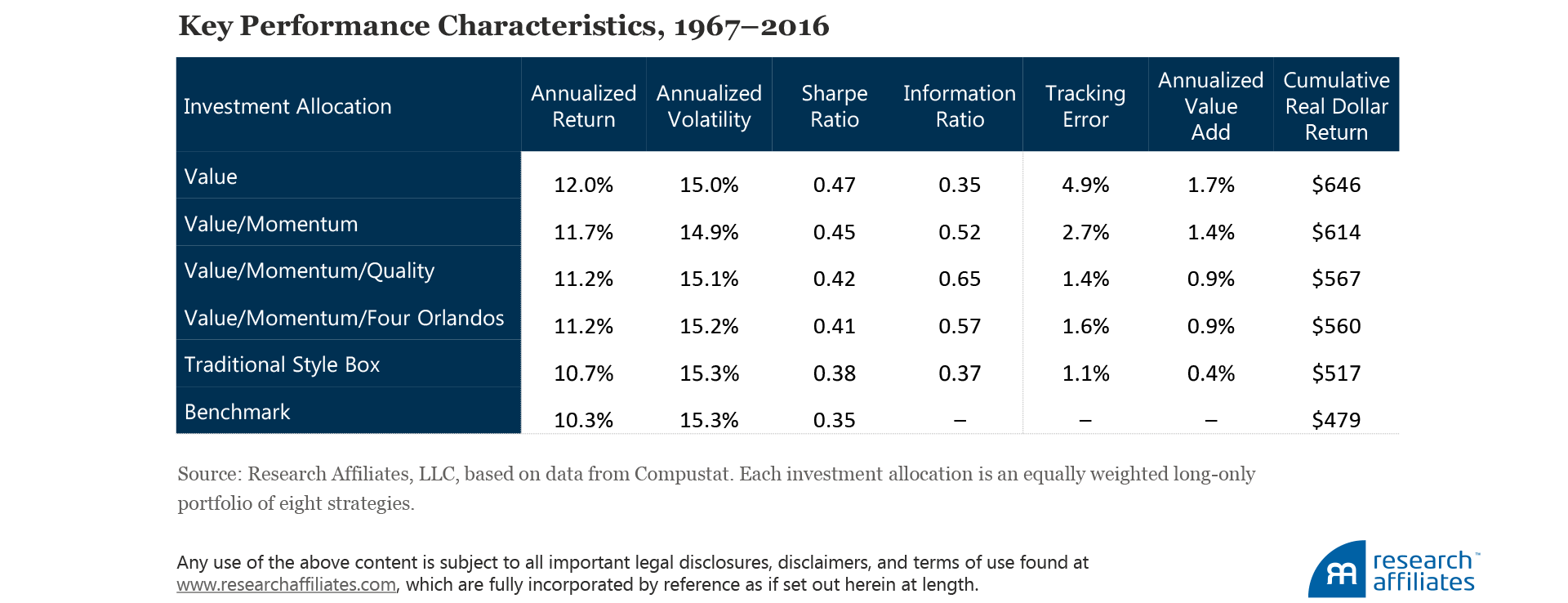
The Value and Value/Momentum allocations have the best long-term performance on a total return and a risk-adjusted basis. While both are sources of robust returns, the agent’s prospect of keeping her job is markedly improved by taking advantage of the diversification benefits of negatively correlated strategies, and allocating to Value/Momentum. We are not suggesting that value outperforms a combination of value and momentum. In fact, Asness, Moskowitz, and Pedersen (2013) and Asness et al. (2015) show that combining value and momentum is a robust source of excess return and tends to outperform standalone value or momentum strategies. In our example, allocating to value and momentum comes with a slight give-up in value-add (from 1.7% to 1.4%) due to two poorly implemented momentum strategies.5 This trade-off between value-add and diversification, however, can still be a prudent one for the principal—for example, if the principal is uncertain about potential future withdrawals and contributions.
The agent may believe even further diversification would enhance the likelihood of not being fired at the end of the evaluation horizon and thus add allocations to the quality strategies or to the four Orlandos. These more diversified portfolios significantly underperform over the long term, delivering a lower value-add by 50–80 basis points (bps) relative to the allocations consisting of only robust strategies. These allocations also reduce the agent’s firing risk from 20% and 30% for the robust strategies to 15% and 16% for the more diversified strategies. The result is an obvious loss to the investor and is where the principal–agent problem becomes crystal clear.
In the extreme, the agent could minimize the probability of being fired with the Traditional Style Box allocation, which produces a value-add of 100–130 bps lower than the robust allocations. Essentially, this “hedged” allocation recreates the benchmark—potentially at higher fees and higher execution costs—and removes close to all the potential benefits of factor investing. The chance of being terminated, however, is practically nil. No wonder the Traditional Style Box dominates today’s investment landscape with $2 trillion of US equity products benchmarked to growth!
The cost to the principal (in other words, the agency cost) of being invested in non-robust strategies can be quite large when compounded over time. In our example, an initial $100 investment in the Value/Momentum strategy grew in real terms to $614 over the 1967–2016 period, roughly $50 more than the cumulative real returns of the Value/Momentum/Quality ($567) and Value/Momentum/Four Orlandos allocations ($560), and $97 more than the Traditional Style Box allocation ($517). An agent’s bias toward low to negatively correlated strategies can potentially cost the principal from around $50 to just under $100 in long-term real return for every $100 invested.
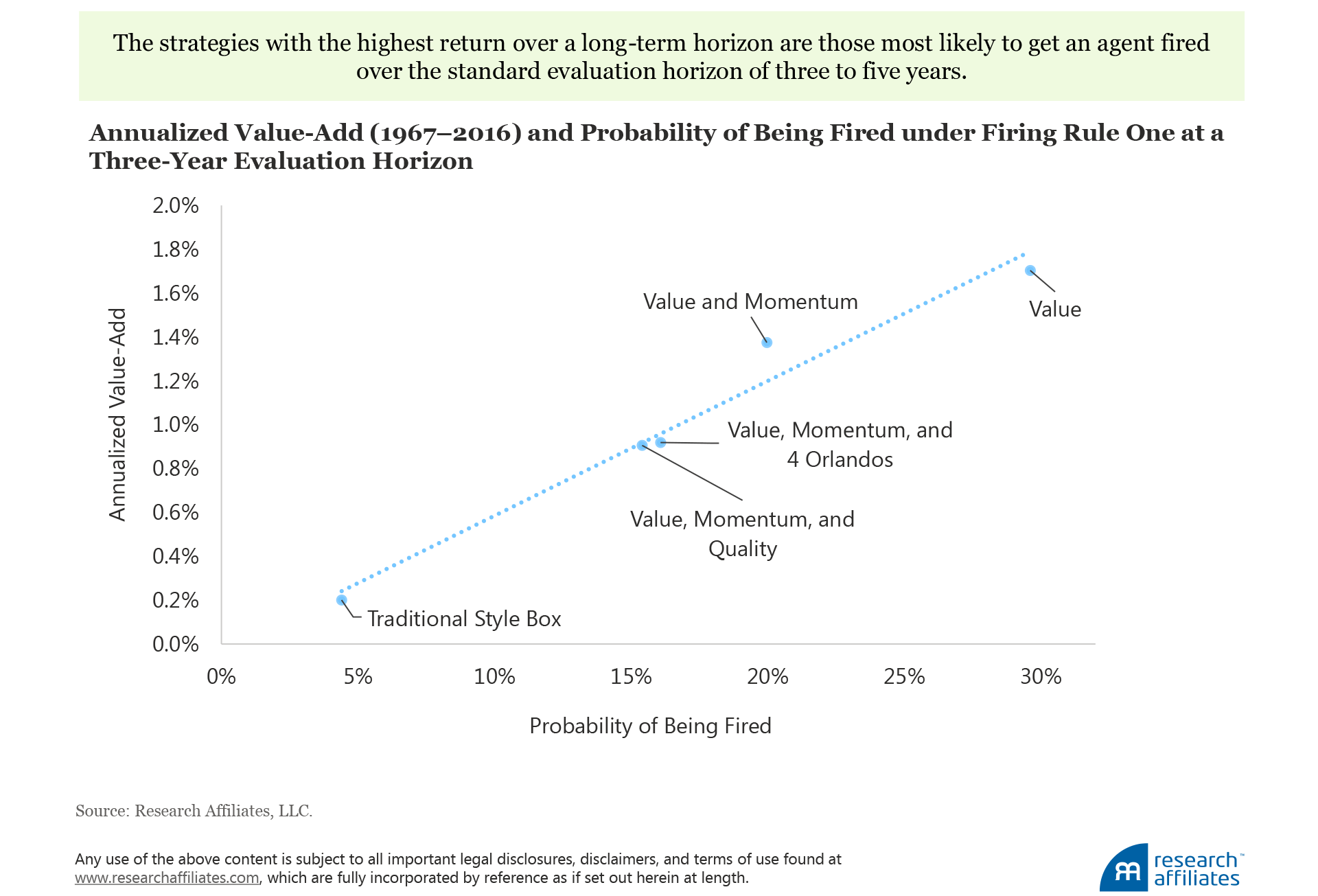
The Rationale for Adding Non-Robust Factors
In our example, the agent is fired less frequently when allocating to a portfolio that produces the lowest information and Sharpe ratios. How can this be? We can illustrate by comparing a robust strategy with 2% average value-add and 4% tracking error and a non-robust strategy with 0% average value-add and 1% tracking error. Although the robust strategy delivers higher value-add, on average, its higher tracking error indicates lower confidence in its ability to perform well over a shorter horizon.6 By contrast, the lower tracking error of the non-robust strategy suggests a higher level of confidence it will outperform the robust strategy over a shorter horizon. With this being the case, the rational action for an agent to take is to choose the non-robust strategy. (A more detailed explanation is provided in the appendix.)
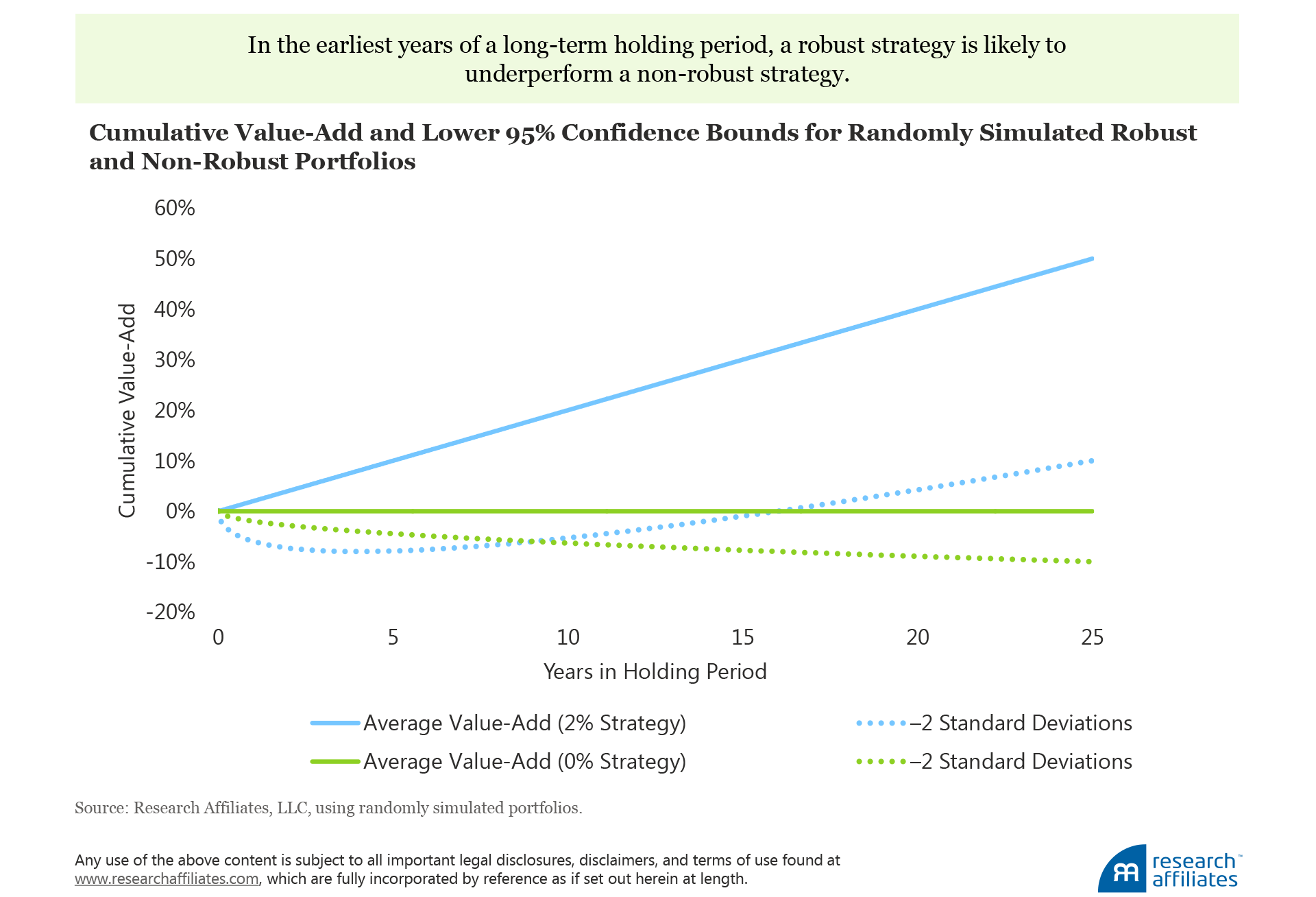
In our example, the agent is fired less frequently when allocating to a portfolio that produces the lowest information and Sharpe ratios. How can this be? We can illustrate by comparing a robust strategy with 2% average value-add and 4% tracking error and a non-robust strategy with 0% average value-add and 1% tracking error. Although the robust strategy delivers higher value-add, on average, its higher tracking error indicates lower confidence in its ability to perform well over a shorter horizon.6 By contrast, the lower tracking error of the non-robust strategy suggests a higher level of confidence it will outperform the robust strategy over a shorter horizon. With this being the case, the rational action for an agent to take is to choose the non-robust strategy. (A more detailed explanation is provided in the appendix.)
How Do We Better Align Incentives?
Agents who attempt to minimize their risk of being fired by allocating funds to non-robust strategies are behaving perfectly rationally. Any fault for suboptimal investor outcomes lies with the incentives produced by the rules and conventions governing the investment management environment, in which we all chose to participate.
As an investment community, we have the opportunity (and the responsibility) to adopt practices that more closely align agent and investor incentives:
1) Increase the length of evaluation period. The probability of being fired declines as the evaluation horizon increases. Over longer horizons the statistical difference between robust and non-robust strategies becomes stronger, which can help mitigate the principal–agent problem. This often means extending the horizon beyond board members’ designated terms.
2) Combine multiple robust strategies. The combination of several robust strategies is beneficial for both the investor and the agent because this allocation significantly reduces the chances over a given period that the overall portfolio will underperform and/or that all styles in the portfolio will underperform.
3) Practice transparent line-item management. During the disarmament negotiations with the USSR, Ronald Reagan famously said: “Trust but verify.” Investment boards are well-advised to follow suit in communicating with their plan sponsors and CIOs. Transparency in the performance of individual styles, the investment process itself, and the resulting overall portfolio performance offers a great tool for communicating between investment boards and their agents.
4) Codify investment beliefs and educate the board. When the agent educates the investment board on empirical findings and the rationale for making (or often more important, not making) certain investing decisions, any period of negative performance is less likely to be viewed as a lack of skill and a reason to fire the agent.
5) Use non-robust strategies consciously. Some managers of non-robust strategies, such as growth, may be extremely skilled in delivering value-add. If an agent has high confidence in such a manager’s skill, foregoing the opportunity may be detrimental to the principal. Furthermore, non-robust strategies may at times be underpriced and ignored by many investors, presenting a tactical opportunity to employ non-robust strategies. Being deliberate about choosing to invest in non-robust strategies, and communicating that deliberation, will act to safeguard both the principal and the agent.
Conclusion
We firmly believe the majority of plan sponsors, CIOs, and other delegated managers are guided in their actions by their fiduciary responsibility to the principals whose funds they manage. Nevertheless, we believe outcomes can be improved by fostering a clear understanding between investors and delegated managers that the latter often have an incentive to protect their jobs by allocating the portfolios they manage across negatively, and even uncorrelated, strategies, even if the result does not produce robust returns for their investors. This principal–agent problem can limit the growth of, and even destroy, investor wealth. Both parties can better align their interests by combining several robust strategies in transparent solutions, by extending the evaluation period, and by more thoroughly educating the investment board and codifying investment beliefs.
Our colleague Rob Arnott noted over 10 years ago that the chasm between the best interests of the investor and those of the asset manager is exacerbated by the fact that everyone has a client:
The portfolio manager reports to the chief investment officer, who reports to the CEO of the asset management firm, who reports to the client’s investment officer, who reports to the treasurer or chief financial officer, who reports to the CEO of the client organization, who reports to the investment committee of the board of directors. Each step in the reporting process increases the pressure to focus on short-term results, in absolute returns and relative to one’s peers (2006).
Not much has changed in the past decade. But by speaking straightforwardly now about how the investment industry can work to better align principals’ and agents’ interests, we may be able to affect positive change for both parties over the next 10 years.
Appendix
We show in the article that agents are fired less frequently as the evaluation horizon increases. To understand why, we simulate eight hypothetical strategies with a 2% average value-add and a 4% tracking error over a 25-year period, showing their performance relative to the capitalization-weighted benchmark.
The two dashed lines in the figure below outline the range of possible values we might expect in a 95% confidence interval. Initially, the confidence bounds expand much faster than the average return, and the lower bound falls away from zero before climbing back toward zero over longer horizons. This means that, in the short run, the chances an investor experiences massive underperformance is higher than in the long run.
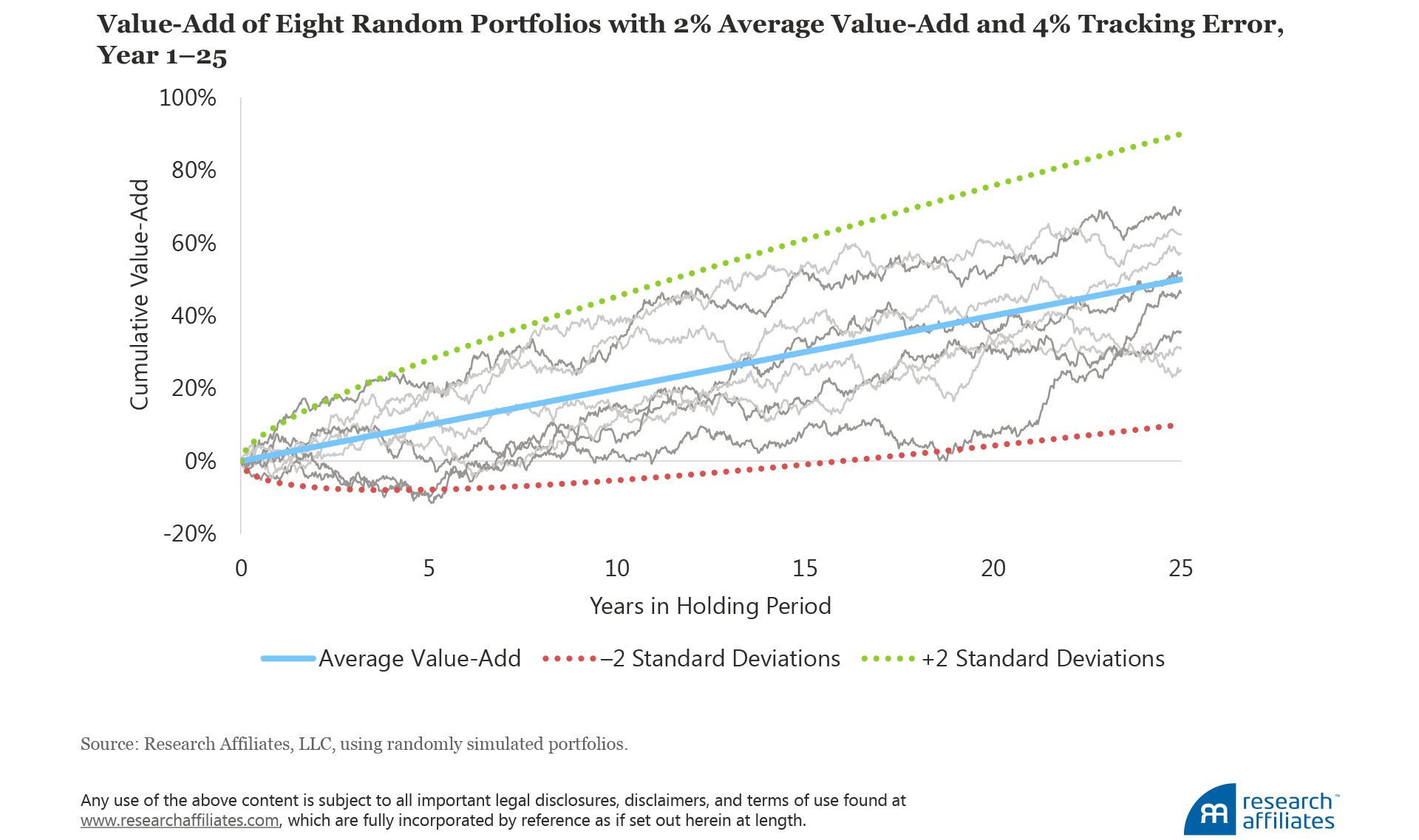
This insight is clearer if we examine the first three years of the 25-year period:
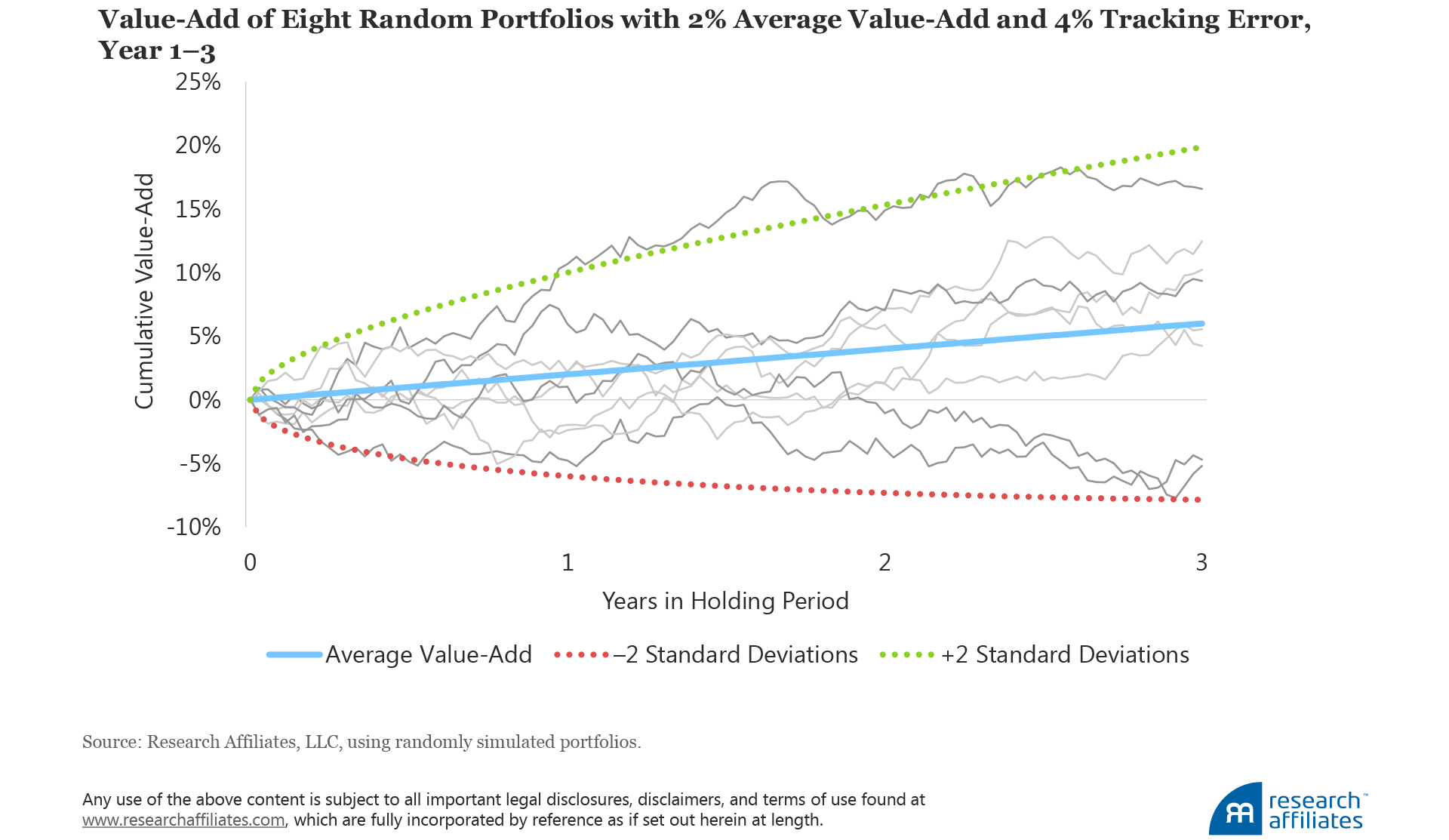
At the one-year horizon almost 38% of the portfolios are expected to underperform; in contrast, at the three-year horizon, the comparable figure is 25% and explains why an agent is fired quite frequently if the evaluation period is short.8 Thus, increasing the evaluation horizon should lead to better alignment of investors’ and their agents’ interests.
To better understand Firing Rule One, the equivalent of line-item risk management, consider an investment allocation that combines eight funds, all positively correlated to each other. The resulting portfolio has an expected average value-add of 2% and a tracking error of 4%. In the long-run (25 years), the portfolio’s outperformance is not far off the average expected value-add, as the following figure illustrates:
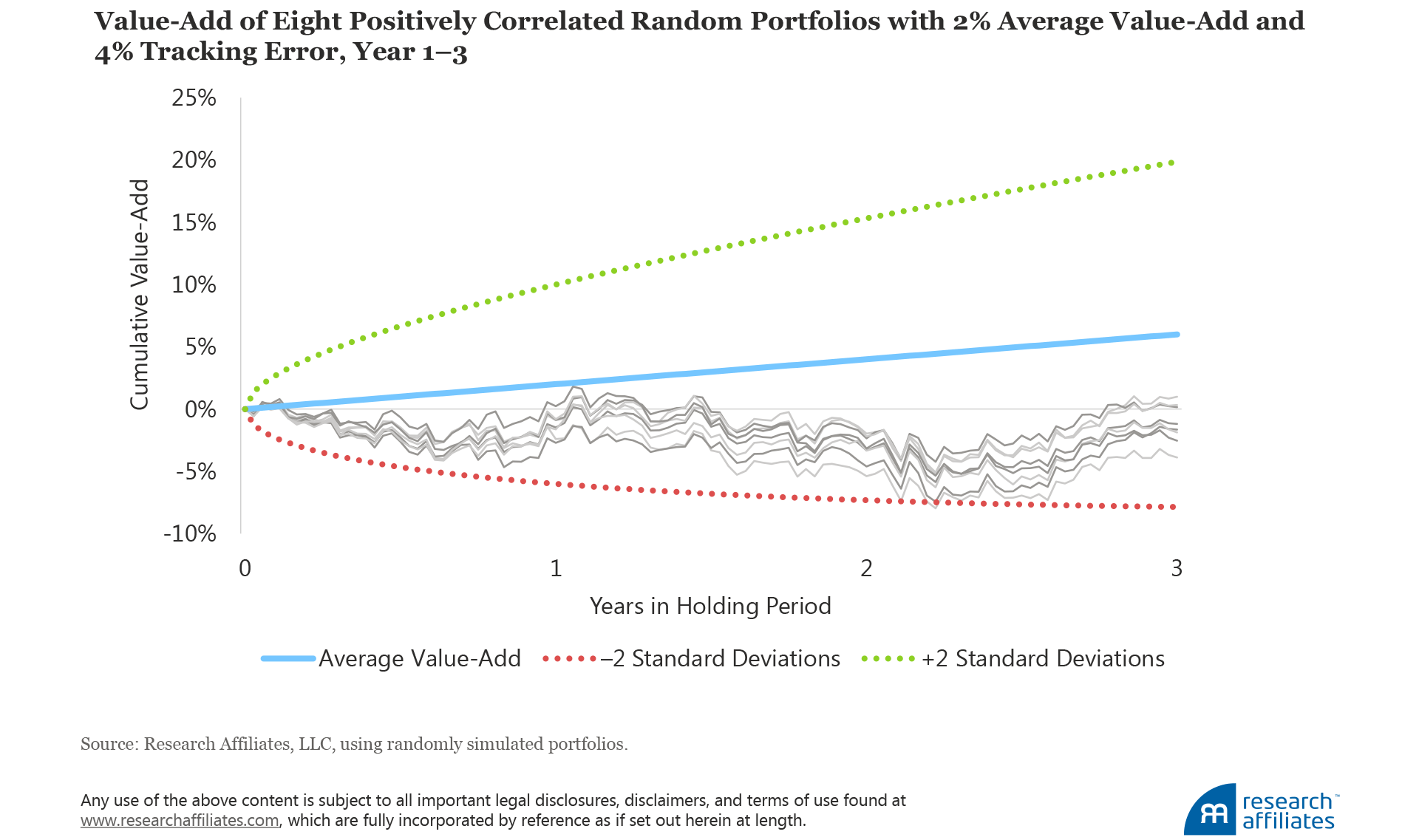
Performance in the first three years of the 25-year period, however, would make any CIO look extremely incompetent in the eyes of their investment board: five of eight strategies underperformed, and the average value-add relative to the benchmark across the eight is an annualized −1.2%.
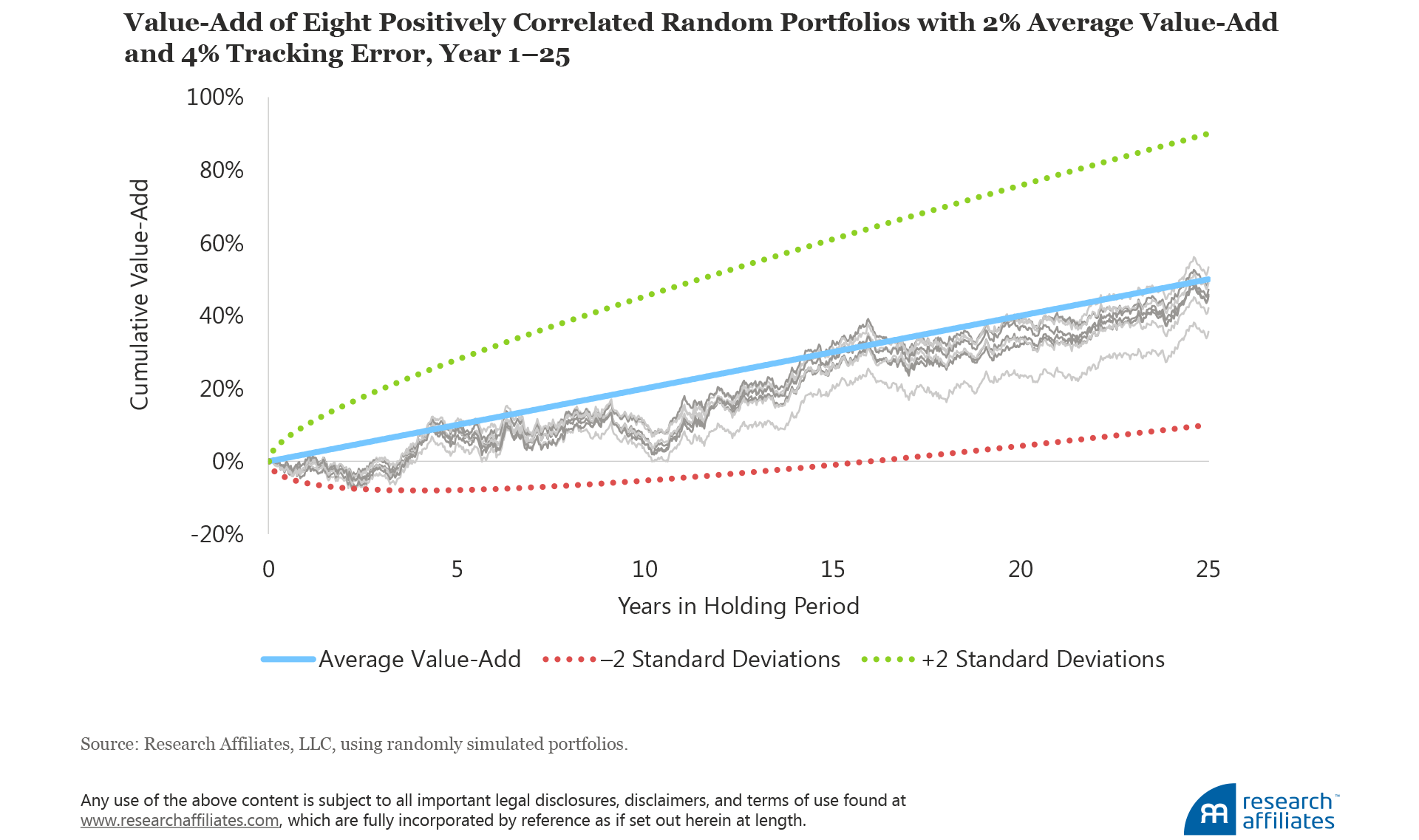
The addition of uncorrelated or negatively correlated investment strategies, regardless of robustness, would significantly reduce the likelihood that the majority of funds would underperform over the short run (the most common evaluation horizon chosen by principals); therein lies the agent’s incentive to lose sight of the principal’s long-term best interest.
Endnotes
1. Today, many investment options offered as smart beta strategies, quickly becoming synonymous with factor investing, are not robust sources of long-run returns. Beck et al. (2016) present a framework under which a factor is considered to be robust if it: 1) is sufficiently well explored in the academic literature, 2) is robust to perturbations in definition, and 3) provides a return advantage in different geographies. Beck et al. find that value, momentum, and low beta factors are robust sources of long-run returns, whereas several popular factors, such as size, are not. The robustness of the quality factor, now that “quality” has come to mean many different things, is largely dependent on the way quality is defined.
2. More information is available on the potential costs to investor performance arising from “shorter” evaluation horizons in West and Ko (2014) and Aram and Treussard (2016).
3. The results are qualitatively similar if the firing rule is changed to “Fire the agent if the equally weighted portfolio aggregated from the selected funds underperforms the benchmark by more than 2%.”
4. These value-added returns do not take into account transaction costs.
5. Although value alone appears to generate a higher value-add (1.7%) than the combination of value and momentum (1.4%), the performance differences of 12.0% and 11.7% are not economically meaningful and likely not statistically significant. Note that we are not suggesting value outperforms a combination of value and momentum. The reason value does better in our particular case is that two non-robust versions of momentum are included in the momentum strategies: momentum based on 2-6 month past returns, rebalanced monthly, and 2-12 month past returns, rebalanced annually. To keep the firing rules consistent across perturbations, we need to keep the number of strategies in the allocation fixed at eight, which means that to equally allocate across value and momentum strategies, we need four value and four momentum strategies that are all different in order to mimic variation across different managers. Unlike value, only a limited number of ways to reasonably measure momentum are available, so we are forced to include two that are not very good at capturing the momentum premium. Because these performance measures do not account for implementation issues such as transaction costs, we should not read too much into their relative magnitudes.
6. Under Firing Rule Two, the chances of being fired are directly related to the tracking error because the firing rule is based on an allocation’s threshold value of benchmark underperformance. Under Firing Rule One, the chances of being fired are directly related to the correlation of the strategies in the allocation. Highly correlated strategies increase the chance that, at any given time, more than half of the strategies experience underperformance. We have discussed how diversification across uncorrelated or negatively correlated strategies results in an allocation that approaches the market, which means the more diverse the allocation, the lower the tracking error. So as an allocation’s strategies become less correlated, the allocation’s tracking error declines and along with it, the changes of being fired at any given time due to the simultaneous underperformance of strategies.
7. Technically, the agent is indifferent where these lines cross if all the agent cares about is their own risk of being fired. We assume, however, that the agent also cares about their fiduciary responsibility, and in the case of indifference, will choose the allocation that gives the principal the largest value-add.
8. Mathematically, the expected outperformance grows linearly with time while the confidence bounds grow at a rate proportional to the square root of time. This means that initially the growth is much faster than linear, while over longer horizons, the growth is slower than linear.
References
Aram, Charles, and Jonathan Treussard. 2016. “Greetings from the Cold.” Research Affiliates (March).
Arnott, Robert D. 2006. “The Fiduciary Time Line: Implications for Asset Allocation.” Editor’s Corner, Financial Analysts Journal, vol. 62, no 2 (March/April):8–10.
Asness, Cliff, Andrea Frazzini, Ronen Israel, and Tobias Moskowitz. 2015. “Fact, Fiction, and Value Investing.” Journal of Portfolio Management, vol. 42, no. 1 (Fall):34–52.
Asness, Cliff, Tobias Moskowitz, and Lasse H. Pedersen. 2013. “Value and Momentum Everywhere.” Journal of Finance, vol. 68, no. 3:929–985.
Beck, Noah, Jason Hsu, Vitali Kalesnik, and Helge Kostka. 2016. “Will Your Factor Deliver? An Examination of Factor Robustness and Implementation Costs.” Financial Analysts Journal, vol. 72, no. 5 (September/October):58–82.
Ellis, Charles. 1985. Investment Policy: How to Win the Loser’s Game. Homewood, IL: Dow Jones-Irwin.
King, Mark. 2013. “Investments: Orlando Is the Cat’s Whiskers of Stock Picking.” The Guardian.com (January 13).
West, John, and Amie Ko. 2014. “Hiring Good Managers Is Hard? Ha! Try Keeping Them.” Research Affiliates (November).
